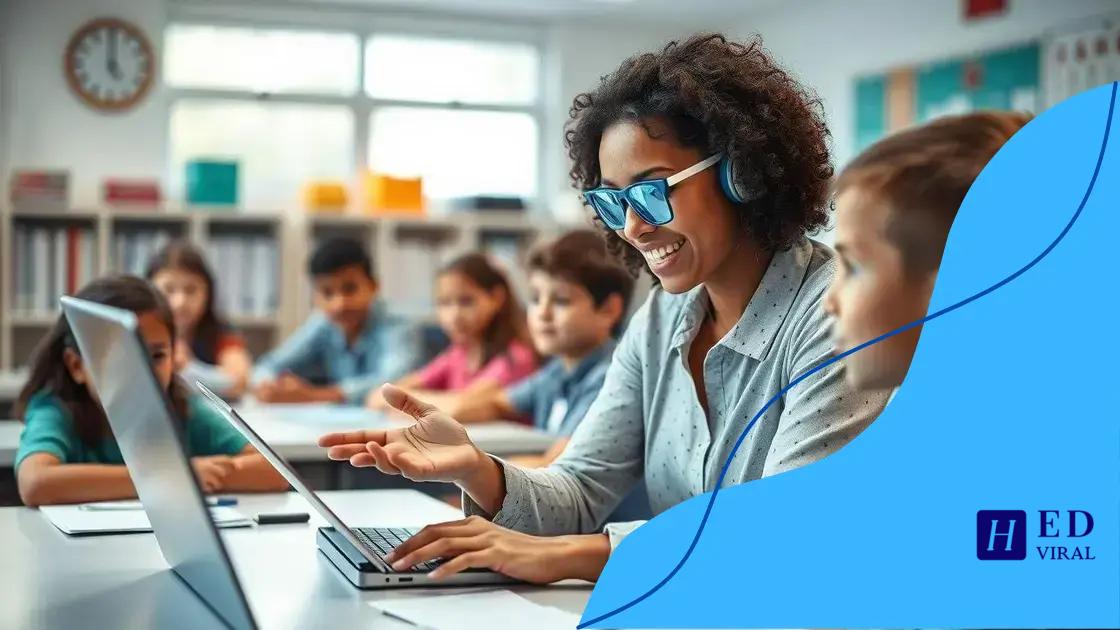Gamification in classrooms: boosting engagement through play

Gamification in classrooms enhances student engagement by incorporating game-like elements, such as rewards and challenges, fostering a more interactive and motivating learning environment.
Gamification in classrooms is transforming the way students interact with learning materials. Imagine a classroom where lessons feel like games—engaging, fun, and rewarding. This approach not only captivates students but also fosters deeper learning experiences.
Understanding gamification in education
Understanding gamification in education begins with realizing its potential to transform traditional learning. By incorporating game-like elements, educators can significantly boost student engagement and motivation.
What is Gamification?
Gamification refers to the application of game design elements in non-game contexts. In classrooms, this means using points, rewards, and challenges to make learning more interactive and enjoyable. Students who participate in gamified learning environments often find tasks less daunting and more inviting.
Key Elements of Gamification
When teachers integrate gamification strategies, several key components are usually included:
- Points and Scoring: Students earn points for completing tasks, encouraging continuous participation.
- Levels: Achieving different levels creates milestones that foster a sense of progression.
- Badges: Awards for achievements can motivate students by recognizing their efforts.
- Leaderboards: Friendly competition can inspire students to perform better.
This interplay of game mechanics with learning not only keeps students interested but also helps them retain information longer. For example, when a history lesson is framed as a quest, students are more likely to immerse themselves in the material.
Moreover, gamification promotes collaboration among peers. Group tasks or challenges encourage teamwork, allowing students to learn from each other in a fun and engaging way. In this environment, they can share strategies, celebrate their successes, and collectively navigate downfalls.
Why It Matters
Understanding gamification in education is crucial because it aligns perfectly with the natural instincts of students to play and compete. The thrill of achieving a high score, completing a challenge, or unlocking a new level can make learning a joyous adventure rather than a burdensome obligation. It’s essential for educators to embrace this methodology not just as a teaching tool but as a means to cultivate a proactive learning community.
Key benefits of play in learning
The key benefits of play in learning are numerous, enhancing not only engagement but also cognitive development. When students participate in play-based activities, they learn in an environment that promotes curiosity and creativity.
Enhanced Engagement
One of the most significant benefits is increased engagement. Students who engage in play feel motivated to participate actively. They become more invested in their learning process, which often leads to improved academic performance.
Developing Critical Thinking
Through play, students develop critical thinking skills. They are encouraged to solve problems, make decisions, and think creatively about various scenarios. For example, role-playing activities often require students to navigate complex social situations, enhancing their ability to analyze and respond effectively.
- Social Skills: Students learn to communicate and collaborate with others.
- Emotional Growth: Play allows students to understand and manage their emotions better.
- Physical Coordination: Active play improves motor skills and overall physical health.
Furthermore, play fosters a safe space for failure. In a playful setting, students can experiment and learn from their mistakes without the pressure of traditional assessment. This approach encourages a growth mindset, making it easier for them to face challenges in other areas of study.
Additionally, play in learning supports diverse learning styles. Whether through visual aids, hands-on activities, or collaborative games, every student can find a method that resonates with them. By incorporating various play elements, educators can cater to individual needs effectively.
Strategies for implementing gamification

Strategies for implementing gamification in classrooms can vary, but they all focus on increasing student engagement and improving learning outcomes. By integrating game-like elements into lessons, teachers can create dynamic and interactive environments that motivate students to participate actively.
Define Clear Objectives
To start, it’s essential to define clear educational objectives. Knowing what you want students to achieve helps you select appropriate game mechanics. These objectives guide the gamification process and ensure that activities align with your teaching goals.
Incorporate Game Mechanics
One effective approach is to incorporate game mechanics such as:
- Reward Systems: Establish points or badges for completing tasks to foster a sense of achievement.
- Levels: Create progressive levels that allow students to show growth and mastery over time.
- Challenges: Use timed challenges or problem-solving tasks to spark excitement and friendly competition amongst students.
By mixing these elements, you can create an engaging atmosphere while helping students learn more effectively. Additionally, let students have some input on what rewards they value, this can increase motivation.
Another strategy is to use storytelling. Framing lessons within a narrative can captivate students’ interest. For instance, transforming a history lesson into a time-travel adventure captures their imagination and makes the learning process more appealing. When students feel part of a story, they are likely to retain information better.
Utilize Technology
Incorporating technology also enhances gamification strategies. There are many educational apps available that allow teachers to create interactive experiences. Platforms like Kahoot! and Quizizz enable real-time quizzes with a competitive twist. These platforms encourage participation and can make assessment more fun.
Finally, always assess the effectiveness of your gamification strategies. Gather feedback from students about what they enjoyed and what could be improved. This iterative process helps refine your approach, ensuring it meets the needs of your learners.
Examples of successful gamification in schools
Examples of successful gamification in schools can inspire educators looking to enhance classroom engagement. These real-life cases demonstrate how integrating game elements can create memorable learning experiences.
Classroom Quest
One notable example is the Classroom Quest program, which gamifies the typical school experience. Students earn points for completing assignments and demonstrating positive behavior. Points unlock different rewards, like homework passes or extra recess time, fostering a competitive yet friendly atmosphere.
Science Adventures
Another great illustration is the use of gamified learning in science classes, where students embark on “science adventures.” Teachers create interactive modules that simulate real-world scientific challenges. Students work in teams to solve problems and earn badges for their achievements.
- Hands-on Learning: These adventures encourage practical learning.
- Teamwork: Working together fosters collaboration and communication.
- Critical Thinking: Students must think critically to overcome challenges.
This approach makes complex concepts easier to grasp because students actively participate in the learning process. It turns abstract theories into real-life applications.
Additionally, many schools have implemented a points-based leaderboard system. In these systems, students track their progress and compare it with their peers. By introducing elements like this, schools cultivate an environment of healthy competition, motivating students to do their best.
Literature and Media Studies
In literature classes, gamification can involve role-playing games where students take on the personas of characters from books they are reading. In doing so, they engage with the text on a deeper level. Discussing character motivations and plot developments becomes more dynamic when students act out scenes. This method not only aids comprehension but also enhances creativity.
These examples show how gamification in education can transform typical lessons into interactive and enjoyable experiences. Educators can learn from these successes and tailor their gamification strategies to fit their unique classroom needs.
Measuring the impact of gamification
Measuring the impact of gamification in education is essential to understand its effectiveness. By evaluating how gamified strategies affect student engagement and learning outcomes, educators can make informed decisions about their teaching methods.
Setting Clear Metrics
To effectively measure impact, it’s crucial to set clear metrics before implementing gamification. These metrics can include:
- Engagement Levels: Monitor attendance, participation during activities, and the time students spend on tasks.
- Academic Performance: Compare test scores and grades before and after gamification is applied.
- Student Feedback: Collect opinions from students about their learning experiences and enjoyment of gamified activities.
These metrics give educators data to track improvements in classroom dynamics and academic achievements.
Using Surveys and Observations
In addition to setting metrics, using surveys and observations can provide valuable insights. Surveys allow students to express their feelings about gamified lessons. This can help teachers gauge whether students find the learning process more enjoyable and effective.
Observation in classrooms is another method. Teachers can note changes in student behavior, such as increased collaboration, enthusiasm, and willingness to engage with the material.
Analyzing Data Over Time
Analyzing data over time is critical to understanding long-term effects. Educators should consistently gather information throughout the school year. This allows for an in-depth analysis of trends and helps identify what strategies are most effective.
When evaluating the results, it’s important to remember that not all students will respond the same way. Some may thrive in a gamified setting, while others may need additional support to engage fully. Therefore, adapting strategies based on data is key to maximizing the benefits of gamification in education.
Ultimately, measuring the impact of gamification enables educators to refine their approaches and create more dynamic, effective learning environments.
In conclusion, gamification in classrooms offers a fresh and exciting way to engage students. By incorporating game-like elements, educators can create dynamic learning environments that foster motivation and improve academic achievement. The key benefits include enhanced engagement, critical thinking development, and collaboration among peers. Measuring the impact of these strategies is crucial for continuous improvement, allowing teachers to adapt their methods based on data and feedback. As we aim to create more inclusive and effective educational experiences, embracing gamification can be a powerful step forward.
FAQ – Frequently Asked Questions about Gamification in Classrooms
What is gamification?
Gamification is the use of game elements in non-game contexts, like classrooms, to enhance student engagement and learning.
How does gamification improve student engagement?
By incorporating game-like elements such as points, rewards, and challenges, gamification makes learning more interactive and motivating.
What are some effective gamification strategies?
Effective strategies include defining clear objectives, using game mechanics like levels and badges, and incorporating storytelling in lessons.
How can I measure the success of gamification in my classroom?
You can measure success by setting clear metrics, using surveys for student feedback, and analyzing academic performance over time.






